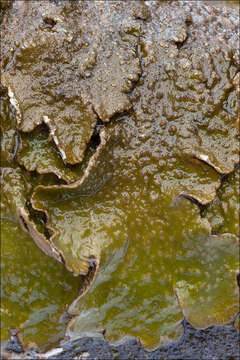Melanelixia-subaurifera_3b

Description:
Melanelixia subaurifera (Nyl.) O. Blanco et al., syn.: syn.: Melanelia subaurifera (Nyl.) Essl., Parmelia olivacea var. subaurifera (Nyl.) O.J. Rich., Parmelia subaurifera Nyl.Abraded Camouflage Lichen, DE: Gold-BrownflechteSlo.: zlati rjavekDat.: Jan. 13. 2018Code: Bot_1104/2018_DSC0236 Lat.: 46.36026 Long.: 13.702619Habitat: abandoned pastures with scattered trees; moderately inclined mountain slope, south-east aspect; relatively warm and dry place; colluvial, calcareous ground, sunny place; exposed to direct rain; average precipitations ~ 3.000 mm/year, average temperature 7-9 deg C, elevations 600 m (1.950 feet), alpine phytogeographical region. Substratum: bark of small branches and twigs of a stand-alone, recently cut down Juglans regia.Place: Lower Trenta valley, right bank of river Soa; between villages Soa and Trenta; near Trenta 2b cottage, East Julian Alps, Posoje, Slovenia EC.Comment: Melanelixia subaurifera is a rather small, only a few cm in diameter, adpressed, thin, matt and brown lichen. When dry and growing on brown, rough tree bark it requires some attention to be spotted. When damp, after rain, it becomes olive green and shinier and hence quite conspicuous. It is a widely distributed all over the world and on many places a common lichen.Habitus of the find seems quite convincing for Melanelixia subaurifera. Optional similar species Melanelixia subargentifera was abandoned because I was able to find neither tiny cortical hairs toward lobe margins and ends (Ref.1) nor purine on the thallus (Ref.5). The lichens were not found on tree's trunk or at the base of it (Ref.2), but rather on small twigs, which doesn't match to Melanelixia subargentifera. However, Melanelixia can be easily confused also with brown species of Xanthoparmelia species. Morphological differences are small, however, chemistry is different. My determination is not completely reliable because no chemical tests have been done.Naming of this species is also to some extent questionable. Index Fungorum keeps the name Melanelixia subaurifera as a synonym of 'current name' Melanelia subaurifera, while MycoBank claims the opposite. It seems to me that recent references mostly follow MycoBank.Lichens of this observation were photographed in damp state. Many specimens were found on this tree. Ref.: (1) C.W.Smith, et all, The lichens of Great Britain and Ireland,The British Lichen Society,(2009), p 572.(2) V. Wirth, Die Flechten Baden-Wrttembergs, Teil.2., Ulmer (1995), p 656. (as Parmelia subaurifera)(3) F.S. Dobson, Lichens, The Richmonds Publishing Ca.LTD (2005), p 264. (as Melanelia subaurifera)(4) lichenportal.org/portal/imagelib/imgdetails.php?imgid=192575 (accessed May 22. 2018) (5) I.M. Brodo, S.D. Sharnoff, S.Sharnoff, Lichens of North America, Yale Uni. Press (2001), p 439. (as Melanelia subaurifera)(6) www.waysofenlichenment.net/lichens/Melanelixia%20subaurifera (7) dbiodbs.units.it/italic/chiavi_pub25?usr=admin&n=716&...
Included On The Following Pages:
- Life (creatures)
- Cellular (cellular organisms)
- Eukaryota (eukaryotes)
- Opisthokonta (opisthokonts)
- Nucletmycea
- Fungi (mushrooms, lichens, molds, yeasts and relatives)
- Dikarya
- Ascomycota (sac fungi)
- Lecanoromycetes
- Lecanorales
- Parmeliaceae
- Melanelixia
- Melanelixia subaurifera (Abraded Camouflage Lichen)
This image is not featured in any collections.
Source Information
- license
- cc-by-nc-sa
- copyright
- Amadej Trnkoczy
- photographer
- Amadej Trnkoczy
- original
- original media file
- visit source
- partner site
- Flickr Group
- ID


